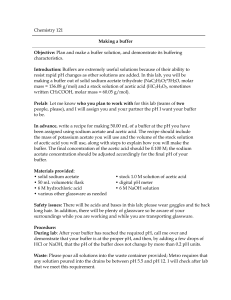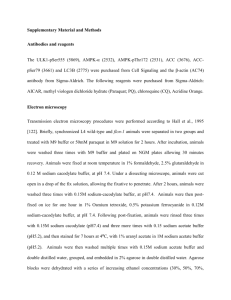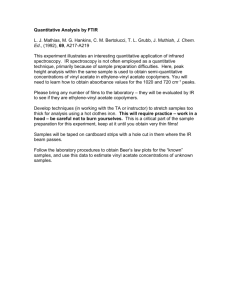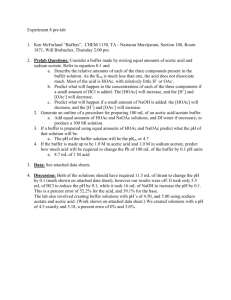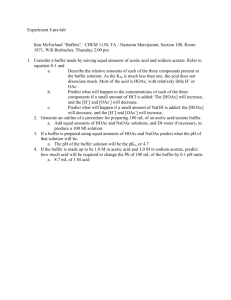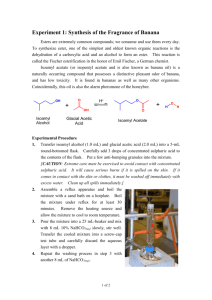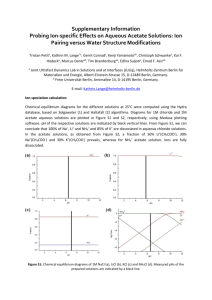Table 2: Sample preparation, instrumental analysis, validation
advertisement
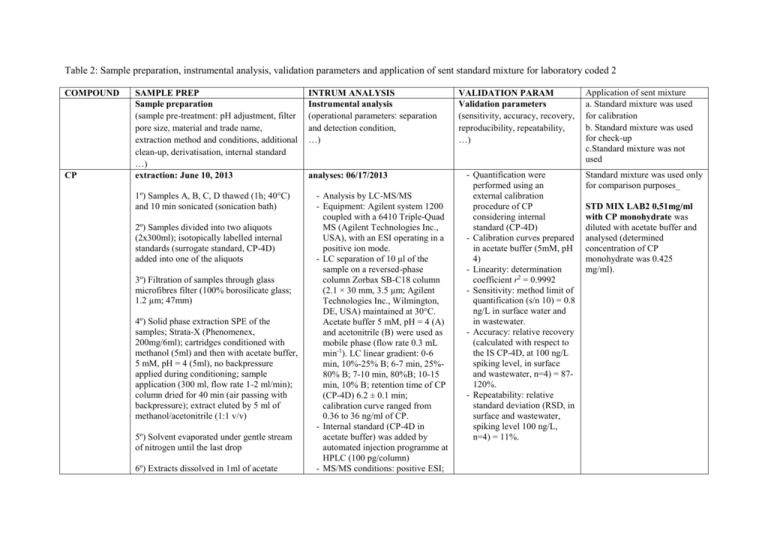
Table 2: Sample preparation, instrumental analysis, validation parameters and application of sent standard mixture for laboratory coded 2 COMPOUND CP SAMPLE PREP Sample preparation (sample pre-treatment: pH adjustment, filter pore size, material and trade name, extraction method and conditions, additional clean-up, derivatisation, internal standard …) extraction: June 10, 2013 1º) Samples A, B, C, D thawed (1h; 40°C) and 10 min sonicated (sonication bath) 2º) Samples divided into two aliquots (2x300ml); isotopically labelled internal standards (surrogate standard, CP-4D) added into one of the aliquots 3º) Filtration of samples through glass microfibres filter (100% borosilicate glass; 1.2 µm; 47mm) 4º) Solid phase extraction SPE of the samples; Strata-X (Phenomenex, 200mg/6ml); cartridges conditioned with methanol (5ml) and then with acetate buffer, 5 mM, pH = 4 (5ml), no backpressure applied during conditioning; sample application (300 ml, flow rate 1-2 ml/min); column dried for 40 min (air passing with backpressure); extract eluted by 5 ml of methanol/acetonitrile (1:1 v/v) 5º) Solvent evaporated under gentle stream of nitrogen until the last drop 6º) Extracts dissolved in 1ml of acetate INTRUM ANALYSIS Instrumental analysis (operational parameters: separation and detection condition, …) analyses: 06/17/2013 - Analysis by LC-MS/MS - Equipment: Agilent system 1200 coupled with a 6410 Triple-Quad MS (Agilent Technologies Inc., USA), with an ESI operating in a positive ion mode. - LC separation of 10 μl of the sample on a reversed-phase column Zorbax SB-C18 column (2.1 × 30 mm, 3.5 μm; Agilent Technologies Inc., Wilmington, DE, USA) maintained at 30°C. Acetate buffer 5 mM, pH = 4 (A) and acetonitrile (B) were used as mobile phase (flow rate 0.3 mL min-1). LC linear gradient: 0-6 min, 10%-25% B; 6-7 min, 25%80% B; 7-10 min, 80%B; 10-15 min, 10% B; retention time of CP (CP-4D) 6.2 ± 0.1 min; calibration curve ranged from 0.36 to 36 ng/ml of CP. - Internal standard (CP-4D in acetate buffer) was added by automated injection programme at HPLC (100 pg/column) - MS/MS conditions: positive ESI; VALIDATION PARAM Validation parameters (sensitivity, accuracy, recovery, reproducibility, repeatability, …) - Quantification were performed using an external calibration procedure of CP considering internal standard (CP-4D) - Calibration curves prepared in acetate buffer (5mM, pH 4) - Linearity: determination coefficient r2 = 0.9992 - Sensitivity: method limit of quantification (s/n 10) = 0.8 ng/L in surface water and in wastewater. - Accuracy: relative recovery (calculated with respect to the IS CP-4D, at 100 ng/L spiking level, in surface and wastewater, n=4) = 87120%. - Repeatability: relative standard deviation (RSD, in surface and wastewater, spiking level 100 ng/L, n=4) = 11%. Application of sent mixture a. Standard mixture was used for calibration b. Standard mixture was used for check-up c.Standard mixture was not used Standard mixture was used only for comparison purposes_ STD MIX LAB2 0,51mg/ml with CP monohydrate was diluted with acetate buffer and analysed (determined concentration of CP monohydrate was 0.425 mg/ml). buffer (5 mM, pH = 4) using sonication in bath (3 min); residual particles observed in sample D removed by filtration (0.45 µm, nylon) 7º) Extracts frozen at -18°C prior analyses and then analyzed as described 8º) For the samples where CP was out of the range of the calibration curve were further diluted in the acetate buffer and re-analyzed MRM mode with collision energy 22 eV; the capillary and cone voltage 2000 V and 130 V, respectively. The m/z transitions 261.1>140.0 for CP and 265.1>144.0 for CP-4D

